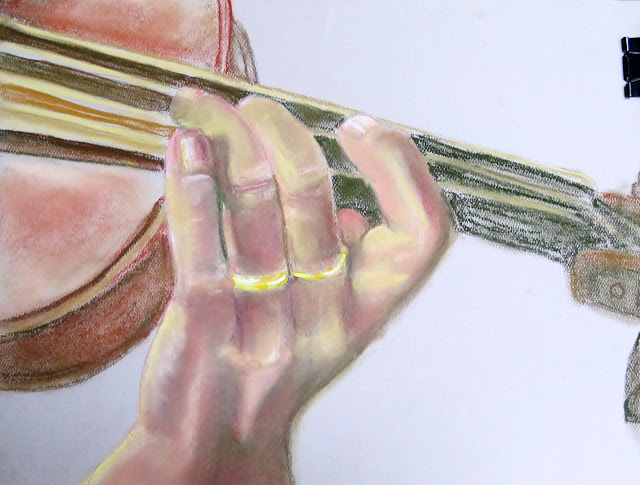 |
| "Sandhill Cranes at Twilight" 24 x 30 acrylic on canvas, in gold frame with black liner |
It happens gradually that transition between learning a skill and mastering it.
One day you realize you’ve mastered a color mixture or a technique. You’re
painting a face or a landscape with confidence and with fewer brush strokes.
You’ve gone pro.
It happened to me while painting a leaf. In the beginning
I’d try to mimic what I saw unsuccessfully. There was usually too much paint on
my brush and only a gut feeling of what to do. My mind didn’t seem to be
engaged. That may be a good thing once you’ve mastered a skill or technique,
but in the beginning concentration and execution take thought. As the T.V.
artist, Jenkins’ said to his students: “Don’t rush the brush.”
 |
| "Maestro" Work-in-Progress 9 x 12 pastel on Bristol |
Now I find myself painting intuitively and skillfully.
Instead of adding veins on the leaves as an afterthought, I leave lighter line
areas untouched, forcing the creation of realistic veins without having to
paint them. This was an eye opener. I could do this with other things: the
smile lines on a child’s face, creases in an older man’s forehead. Instead of
painting hard lines which often age a younger face, I could place shadow next
to the highlight for a softer looking crease.
These simple revelations come to all of us as we practice
our trade. The more you do something, more ways open up to do the same thing in
a more efficient and realistic way. I found myself telling a few other artists
how to paint portraits. I remember thinking: “wow, so now you’re the expert?”
 |
| "Maestro" 9 x 12 Pastel on Bristol |
We all have self doubts. But once we cross that threshold
of confidence and skill, there’s no going back. The next step is to start
acting and thinking like a professional. In the beginning we worry about pricing.
We see every mistake we ever made on a canvas, and wonder who would buy it? We
price our efforts low and even feel somewhat guilty in trying to sell our
wares.
Oh, go on – I know you've felt this way, too. After a few
sales and some commissioned work, we begin to see our own work the way others
see it. We value our skill and our talents. I use a simple rule of thumb. Width
times length equals value; i.e. 16 x 20 = $320 add price of frame, etc. A good asking
price is $350.
 |
| "Brown Thrasher" 16 x 20 acrylic on canvas |
As your skills increase and your name becomes known, the
prices go up. Always factor in the cost of the frame and the percentage a show
or gallery charges for showing your work (30-40%) and price accordingly.
Once you cross over from beginner to Professional, don’t
let anything hold you back.

Wow! If you replace the painting terms with writing or blogging (two things that I took up spontaneously at the same time), then this applies to how I feel almost exactly (minus the professionalism and financial rewards of course). Great post, spot on.
ReplyDeleteI worked as a free-lance writer for many years before I became an artist. I agree, it works equally well for almost any career.
DeleteHi Carol,
ReplyDeleteWonderful post. It's terrific when you make an artistic or professional breakthrough, that often seems so natural after the event. Einstein said "never stop questioning" and I'm sure that's so true with art.
Great comment, Neil. I've always had a thirst for learning. Sometimes classes don't go fast enough for me. I think that's why with few exceptions, I've been self-taught. I use classes to gauge if I'm on on the mark.
Delete